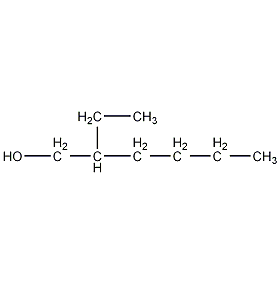
Structural formula
| Business number | 02QL |
|---|---|
| Molecular formula | C8H18O |
| Molecular weight | 130.23 |
| label |
2-Ethylhexanol, Octanol, 2-Ethyl-1-hexanol (isooctanol), Ethylhexanol, isooctyl alcohol, 2-Ethylhexyl alcohol, 2-Ethylhexan-1-ol, 2-Ethyl hexanol, Ester plasticizers, Cold-resistant auxiliary plasticizer, defoamer, alcohol solvents, Dispersant, Lubricant |
Numbering system
CAS number:104-76-7
MDL number:MFCD00004746
EINECS number:203-234-3
RTECS number:MP0350000
BRN number:1719280
PubChem number:24846205
Physical property data
1. Properties: colorless to light yellow oily liquid with sweet and light floral aroma.
2. Boiling point (ºC, 101.3kPa): 184.6
3. Boiling point (ºC, 2.0kPa): 184~185
4. Melting point (ºC ): -70
5. Relative density (g/mL, 25/4ºC): 0.8327
6. Relative vapor density (g/mL, air=1): 4.49
7. Refractive index (n20ºC): 1.4316
8. Viscosity (mPa·s, 20ºC): 9.8
9. Flash point (ºC, opening) : 81
10. Heat of evaporation (KJ/kg): 367.6
11. Specific heat capacity (KJ/(kg·K), 25ºC, constant pressure): 2.36
12. Vapor pressure (kPa, 20ºC): 0.048
13. Vapor pressure (kPa, 79ºC): 1.33
14. Vapor pressure (kPa, 110ºC): 6.67
15. Freezing point (ºC): -70
16. Solubility (%, 20ºC, water): 0.07
17. Volume expansion coefficient (K-1): 0.00073
18. Solubility: Miscible with a variety of organic solvents, can dissolve rubber, resin, wax, vegetable oil, mineral oil, animal oil, dyes, etc. Slightly soluble in water. Soluble 720 times in water.
19. Relative density (25℃, 4℃): 0.8290
20. Refractive index at room temperature (n25): 1.4290
21. Critical temperature (ºC): 366.85
22. Critical pressure (MPa): 2.8
23. Eccentricity factor: 0.594
Combine and dehydrate to obtain 2-ethylhexenal. 2-Ethylhexenal is hydrogenated in the presence of a nickel catalyst at a certain temperature and pressure to produce iso-2-ethylhexanol.
Purpose
1. Used in the production of plasticizers, defoaming agents, dispersants, antioxidants, mineral processing agents and petroleum additives, and also used in printing and dyeing, paint, film, etc. Mainly 2. Used to manufacture ester plasticizers and cold-resistant auxiliary plasticizers for dicarboxylic acids such as phthalic acid, azelaic acid, and sebacic acid. The mixed solvent used in nitrocellulose spray paint can prevent the paint film from turning white. 3.2-Ethylhexanol is commonly called octanol in the plasticizer community, and it is an important chemical raw material. In addition to being used to produce plasticizers abroad, octanol also produces octyl acrylate or is used as a surfactant, etc. It can mainly be used to produce: dioctyl phthalate (DOP), dioctyl oxalate (DOA), Trioctyl trimellitate (TOTM), other plasticizers, octyl acrylate, surfactants, bone oil additives, mining, diesel fuel additives, solvents and dispensing, rust inhibitor esters, other chemicals. Octanol itself is a useful solvent, defoamer, dispersant, and lubricant. Its series of products are mainly plasticizers such as dioctyl phthalate and octyl acrylate. Dioctyl phthalate produced from octanol is the main plasticizer of PVC, and its consumption for PVC accounts for about 95% of its total consumption. 4. It is used as a defoaming agent for white latex, but its ability to break and suppress foam is poor. It is also used as raw material for organic synthesis to produce products such as octyl acrylate, dioctyl phthalate, dioctyl terephthalate and dioctyl sebacate. It is also used as a dispersant, lubricant, antioxidant, emulsifier, mineral processing agent, mercerizing agent, etc. It is also an excellent solvent and is used in paper sizing, latex and photography. The mixed solvent prepared with it can prevent the paint film from turning white when used in nitrocellulose spray paint. 5. Commonly used in baked goods, frozen dairy products, and puddings.

 微信扫一扫打赏
微信扫一扫打赏

